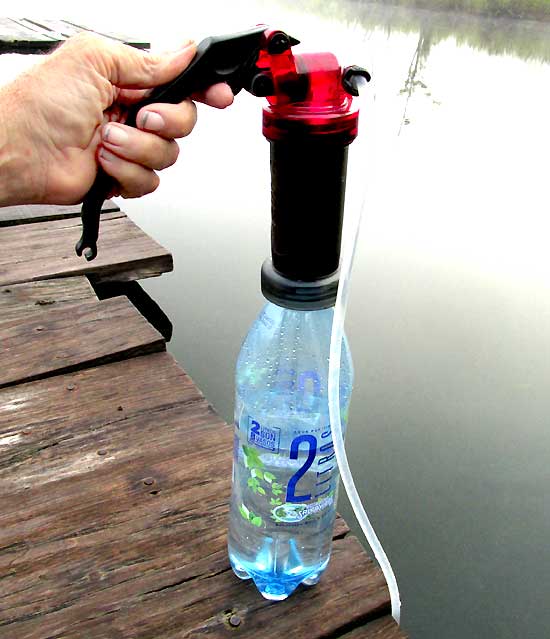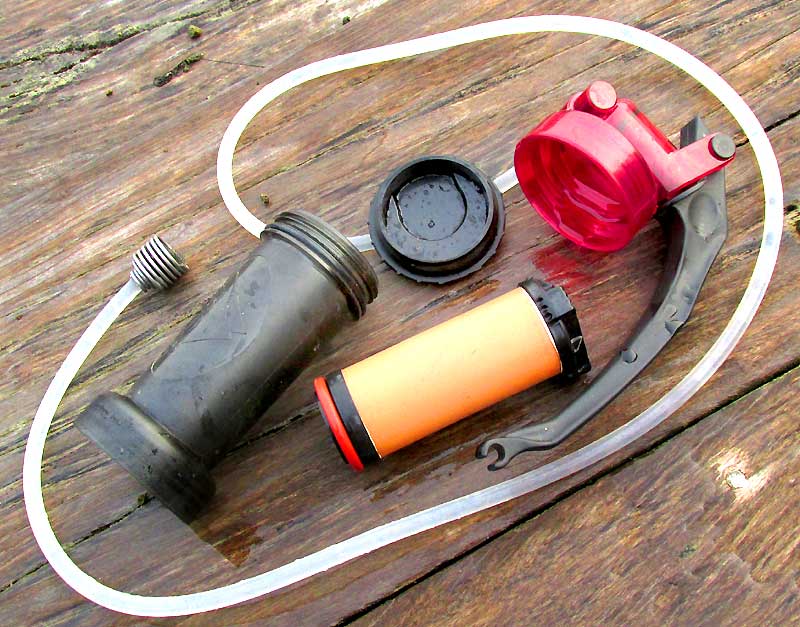Excerpts from Jim Conrad's
Naturalist Newsletter
from the February 15, 2019 Newsletter issued from Rancho Regensis north of Valladolid, Yucatán, MÉXICO;
elevation ~40m (~130 ft), N~20.876°, W~88.170°
USING A PORTABLE WATER FILTER
Last October when I was camping in northern Guatemala's Rosario National Park, no drinkable water was available except as bottled water in the nearest town. However, inside the park there was a little lake with fish in the clear water. I didn't think the water was polluted, but certainly it had microorganisms such as tiny amoebas that can make you very sick. Since getting to town required a long walk, I was glad I'd brought along my portable water filter, which you can see below, set up for producing potable water directly from the lake:

The plastic bottle below the filter is from my last store-bought water supply. Below, you can see the entire filter taken apart to dry after pumping the water:

In that picture the end of the plastic tube that's positioned in the water to be filtered is affixed with a little metal coil that both adds weight to hold the tube in the water, and to retain a plug of spongy "inlet foam," which accomplishes the first filtering, keeping out floating leaves, aquatic insects and the like.
The tube conducts water to the red "pump head" with its black handle. The pump head does no filtering, just fits securely atop the cylindrical, black, plastic "housing" at the picture's left. The fitting must be secure because as the handle is pumped, considerable water pressure is created inside the housing. The main filter is the cylindrical, pale-orange "ceramic element" in the picture's center. This fits inside the housing. The black, plastic, screw-on cover shown above the ceramic element screws onto the housing's base, and also must be secure enough to withstand the water pressure inside the housing.
As the pump handle is worked, water from the source is fed around the ceramic element, not into it. Water pressure forces the pumped water into the ceramic element, which contains microscope pores. Particles larger than the pores stay on the ceramic element's surface. Water reaching the ceramic element's hollow interior contains nothing larger than the pores' diameter, which is 0.2 microns, or 0.0002mm.
The filter doesn't remove salt from seawater, or water contaminated by runoff from mines or agricultural chemicals. Nor does it remove all viruses, radioactive materials or particles smaller than 0.2microns. When you get down to 0.2microns, however, you're dealing with things at the molecular level and to filter that you need more than a backpacker's hand-filter.
When finished filtering, you must use a small scrubbing pad to lightly scour the ceramic element's surface, because that's where the filtered-out gunk accumulates. Scouring erodes the element, so after a certain number of scourings the element has to be replaced. If you don't scour, before long such high pressure must be built up inside the housing that the hose pops off, which is better than having the handle break, which would be the next event.
The filter is rated as producing about one liter (quart) of filtered water per minute, but I'm a little slower than that, not wanting to break that handle. One ceramic element filters about 2000 liters (quarts) of water and endured 30-60 scrubbings, but that depends on water conditions.
The filter shown in the photos is a Miniworks® EX sold my MSR/ Cascade Designs, Inc. of Seattle, Washington.
On my backpacking trips into the back country I always carry this along. Also, I figure it's good to keep one handy just in case the infrastructure breaks down. I think it would do fine filtering water out of a commode or birdbath, and someday it may come to that for a lot of people.